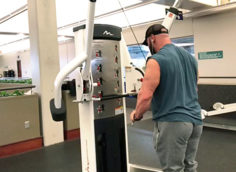Understanding how to get the most out of stored elastic energy in the muscle has helped lifters hit new PRs on their squats. But over-relying on a huge stretch reflex or "bounce" out of the bottom of your squat can also cause a loss of tightness at the bottom. This can lead to posterior pelvic tilt or "butt wink" – your hips rotating backward which causes rounding in your lower back.
When this happens, your body goes too far forward, your butt shoots back, and you end up with an awkward squat that looks more like you're twerking than actually squatting.
You may get away with this for a while, but eventually, your back will have had enough and you'll get injured. Not sure what I'm talking about?
Back Squat – Losing Tightness
Front Squat – Losing Tightness
To save your back, do paused reps. This will increase your static strength from the bottom of the squat since you'll no longer be able to generate a stretch reflex to rebound from the bottom.
Paused Back Squat
Paused Front Squat
Pausing will strengthen your core and hips by increasing your time under tension (TUT) under the bar. Paused reps also help you learn a good bar path –your body will naturally find the most efficient way to keep the bar over your center of gravity.
Find out where you should pause by having someone film you performing light reps from a side view. Go into a full squat and watch the point at which your hips start to rotate back and you see a slight rounding of the lower back. Aim to pause right before this happens.





